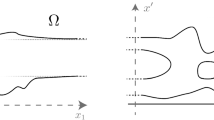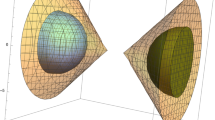Abstract
Symmetry properties of positive solutions of a Dirichlet problem for a strongly nonlinear parabolic partial differential equation in a symmetric domainD ⊂ Rn are considered. It is assumed that the domainD and the equation are invariant with respect to a group {Q} of transformations ofD. In examples {Q} consists of reflections or rotations. The main result of the paper is the theorem which states that any compact inC(D) negatively invariant set which consists of positive functions consists ofQ-symmetric functions. Examples of negatively invariant sets are (in autonomous case) equilibrium points, omega-limit sets, alpha-limit sets, unstable sets of invariant sets, and global attractors. Application of the main theorem to equilibrium points gives the Gidas-Ni-Nirenberg theorem. Applying the theorem to omega-limit sets, we obtain the asymptotical symmetrization property. That means that a bounded solutionu(t) asr→∞ approaches subspace of symmetric functions. One more result concerns properties of eigenfunctions of linearizations of the equations at positive equilibrium points. It is proved that all unstable eigenfunctions are symmetric.
Similar content being viewed by others
References
Angenent, S. B. (1986). The Morse-Smale property for a semi-linear parabolic equation.J. Diff. Eqs. 62, 427–442.
Babin, A. V. (1994). Symmetry of instabilities for scalar equations in symmetric domains (to be published inJ. Diff. Eqs.).
Babin, A. V., and Sell, G. R. (1994). Attractors of nonautonomous parabolic equations and their symmetry properties (in preparation).
Babin, A. V., and Vishik, M. I. (1989).Attractors of Evolution Equations, Nauka, Moscow (English translation: North-Holland, Amsterdam, 1992).
Berestycki, H., and Nirenberg, L. (1991). On the method of moving planes and the sliding method.Bol. Soc. Bras. Mat. 22(1), 1–37.
Brunovský, P., and Fiedler, B. (1988). Connecting orbits in scalar reaction-diffusion equations I. InDynamics Reported I, Wiley, New York, pp. 57–89.
Cerami, G. (1986). Symmetry breaking for a class of semilinear elliptic problems.J. Nonlin. Anal. TMA 10, 1–14.
Dancer, E. N. (1979). On non-radially symmetric bifurcations.J. London Math. Soc. 20, 287–292.
Gidas, B., Ni, W. M., and Nirenberg, L. (1979). Symmetry and related properties via the maximum principle.Oman. Math. Phys. 68, 209–243.
Hale, J. K. (1988).Asymptotic Behavior of Dissipative Systems, Math. Surveys and Monographs, Vol. 25, Am. Math. Soc., Providence, RI.
Haraux, A., and Poláčik, P. (1992). Convergence to a positive equilibrium for some nonlinear evolution equations in a ball.Acta Math. Univ. Comenianae LXI(2), 129–141.
Henry, D. (1985). Some infinite dimensional Morse-Smale systems defined by parabolic partial differential equations.J. Diff. Eqs. 53, 401–458.
Hess, P., and Poláčik, P. (1993). Symmetry and convergence properties for nonnegative solutions of nonautonomous reaction-diffusion problems, Comenius University, Preprint No. M1-93.
Ladyzenskaja, O. A., Solonnikov, V. A., and Ural'seva, N. N. (1968).Linear and Quasilinear Equations of Parabolic Type, Am. Math. Soc., Providence, RI.
Poláčik, P. (1993). Transversal and nontransversal intersections of stable and unstable manifolds in reaction diffusion equations on symmetric domains, Comenius University, Preprint No. M2-93.
Protter, M., and Weinberger, H. (1967).Maximum Principles in Differential Equations, Prentice-Hall, Englewood Cliffs, NJ.
Reed, M., and Simon, B. (1980).Methods of Modern Mathematical Physics, Academic Press, New York.
Serrin, J. (1971). A symmetry problem in potential theory.Arch. Rat. Mech. 43, 304–318.
Smoller, J., and Wasserman, A. (1986). Symmetry-breaking for positive solutions of semilinear elliptic equations.Arch. Rat. Mech. Anal. 95, 217–225.
Author information
Authors and Affiliations
Rights and permissions
About this article
Cite this article
Babin, A.V. Symmetrization properties of parabolic equations in symmetric domains. J Dyn Diff Equat 6, 639–658 (1994). https://doi.org/10.1007/BF02218852
Received:
Issue Date:
DOI: https://doi.org/10.1007/BF02218852




